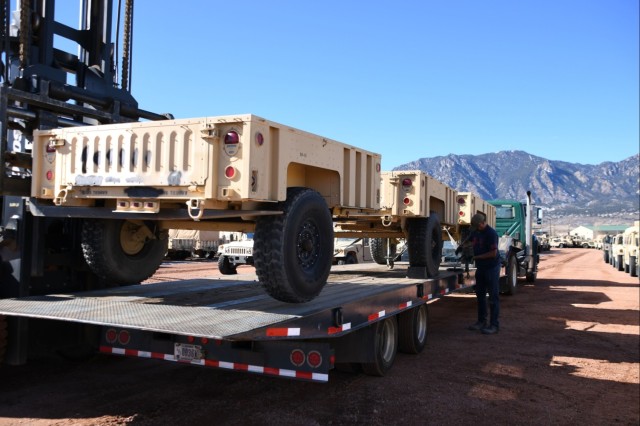
ROCK ISLAND ARSENAL, Ill. — While the U.S. Army Sustainment Command is primarily known for its capabilities in providing Soldiers clothing, equipment, food and more, they're also responsible for the removal, storage and maintenance of many of those same pieces of equipment.
Rapid Removal of Excess, known as R2E, helps alleviate the burden of excess and obsolete equipment, allowing units to focus their time and energy on training.
R2E is a process that removes the burden of excess and obsolete equipment from Soldiers. This allows Soldiers to be ready to rapidly mobilize, deploy and conduct missions worldwide, a critical key to Army readiness.
At this year's Association of the United States Army’s Global Force Symposium and Exhibition, held in Huntsville, Alabama, Brig. Gen. John “Brad” Hinson, ASC commanding general, participated in a panel that addressed Army leaders and supporters about R2E.
"Over the past 10 years, we've had multiple processes that we've gone through in order to turn equipment in," Hinson said, reviewing the history of the process and discussing how it's transformed into what it is today.
As part of that process, modernization displacement and repair sites — known as MDRS — were set up in 2020 and are still in use. Prior to MDRS, only usable equipment could be turned in, leaving broken items to often fall through the cracks. With MDRS, equipment can be repaired if necessary.
Currently, R2E has ongoing operations in Hawaii as well as at Fort Carson, Hinson said, adding that Hawaii has seen around 4,000 turn-ins and Fort Carson is "well above their glide path."
"In fiscal year 2024, units across the Army globally turned in almost a million pieces of equipment," said Misty Misbah, U.S. Army Materiel Command G3 (Logistics) lead materiel integrator. "That's nearly twice as much as in fiscal year 2023. So, this is working. We're getting stuff turned in." AMC develops and delivers materiel readiness solutions to ensure globally dominant land force capabilities. ASC is a subordinate command under AMC.
The R2E process is constantly transforming, and leadership is open to ideas to make it more efficient, both on the ground and in cost. They're pursuing a "back to basics approach," Misbah said.
Hinson agreed, adding that one idea is to have two permanent sites and some "flyaway" teams that can go to different installations to continue the R2E process. This would allow the mission to continue and ensure that obsolete equipment is removed or reduced from Army property books.
Those with boots on the ground are happy with the current R2E process.
"This is a humongous operation," said Col. David Alvarez, 3rd Expeditionary Sustainment Command chief of staff and former Support Operations officer for the 3rd ESC. "Just to show an impact, one day at Fort Bragg MDRS, we processed the same amount of equipment as they normally did in about a month because we went from 10/20 (gear that is fully mission capable) to as-is. That's the level of impact of what you're removing from a company commander or a battalion commander," Alvarez said, adding that leadership also likes that they can block time for equipment turn in and get back on the field rather than it being a year-long process. "That's some of the reason for why it was so successful."
Hinson also credits those behind the scenes tracking the data for turn-ins. Data was efficiently transmitted to U.S. Army Forces Command daily, or sometimes instantly, to prevent overlapping or confusing information. This allowed leadership throughout the process to receive timely updates.
"It was an amazing accomplishment that we never had anybody come back and question the numbers that we turned in on any single day at any installation," Hinson said. Each item was tracked.
"I think the success of this program was because it was so top-down driven in terms of execution," Hinson added. He feels the cooperation and enthusiasm from every rank helps the process run smoothly and efficiently. He said some divisions turned in three times what was expected.
Hinson also spoke about Rapid Removal of Excess Organizational Clothing and Individual Equipment — or R2O — a complementary effort to eliminate excess and unburden Soldiers from carrying unnecessary, legacy and end-of-life individual equipment. He said the hope is that Soldiers will eventually receive new equipment during R2O turn ins.
As a critical element of warfighting, the Army must be able to deliver and sustain ready combat formations that are equipped with the appropriate gear. Taking the burden of excess from units and Soldiers ensures they have the right gear at the right time and can operate their best.

Social Sharing